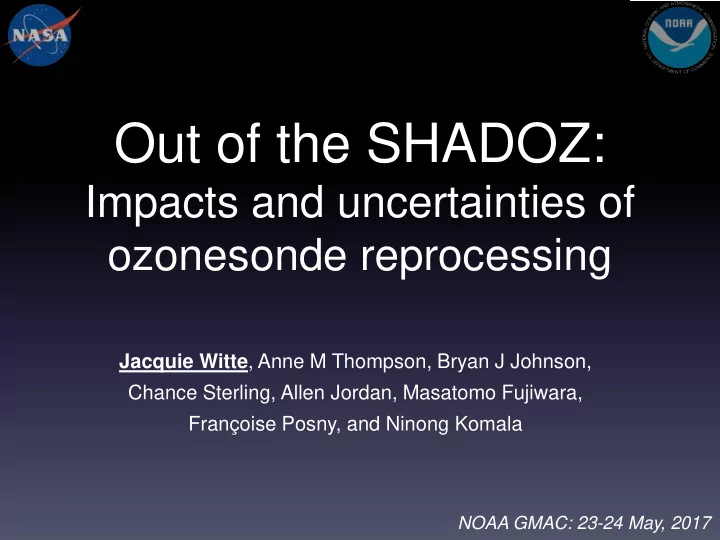

Out of the SHADOZ: Impacts and uncertainties of ozonesonde reprocessing Jacquie Witte , Anne M Thompson, Bryan J Johnson, Chance Sterling, Allen Jordan, Masatomo Fujiwara, Françoise Posny, and Ninong Komala NOAA GMAC: 23-24 May, 2017
Road Map 1. What/Why of Ozonesondes 2. SHADOZ intro 3. Objective 4. Motivation 5. Methods 6. Results 7. Tackling uncertainties 8. Key Points
NOAA/GMD/Mauna Loa What: Ozonesondes 101 • Light-weight, balloon-borne instruments – (usually flown once) that measure O3 and are interfaced with a radiosonde for P-T-U, GPS+. • Developed in the 1960’s by Walter Komhyr and operationally flown in the 1970’s. • ECC type ozonesondes = Electrochemical Concentration Cell sondes. – Measures the current resulting from the release of electrons as ozone reacts with the potassium iodide (KI) solution.
More Ozonesonde Goodness • High vertical resolution ~150m. • Captures features in measurement-deficient regions of the atmosphere: boundary layer, UT/LS, in the case of SHADOZ – QBO/ENSO. • "Neither snow, nor rain, nor heat, nor gloom of night, stays these couriers from the swift completion of their appointed rounds." - Herodotus, 503 B.C. (Inscribed on the General Post Office facility in New York City.) (Source: USPS)
SHADOZ = Southern Hemisphere Additional Ozonesondes - NASA/GSFC reprocessed sites - NOAA/ESRL • PI: Anne M. Thompson (NASA/GSFC) • Main archive of ozonesonde profile data in sub/tropical and remote locations. Nairobi, Kenya • 1998-present. Currently > 7000 profiles. • Open access primary source: – https://tropo.gsfc.nasa.gov/shadoz
Road Map 1. What/Why of Ozonesondes 2. SHADOZ intro 3. Objective 4. Motivation 5. Methods 6. Results 7. Tackling uncertainties 8. Key Points
Objective Homogenize the SHADOZ data records • There are inhomogeneities in the ozonesonde ozone data records due to changes in 1. Operating procedures 2. ECC manufacturer/Solution 3. Ozonesonde/radiosonde system Ozonesonde measurements are sensitive to these changes. We can easily observe the discrepancies in a given records time series due to one or a combination of these changes.
In the SHADOZ Era 7 ECC/Solution pairs used 1. SPC / 1% Full buffer WMO recommended standards 2. ENSCI / 0.5% Half buffer 3. SPC / 0.5% Half buffer 4. ENSCI / 1% Full buffer 6 Radiosonde/Ozonesonde Systems: 5. ENSCI / 2% Unbuffered • 3 Long-term (Since 1990’s) 6. ENSCI / 1%, 1/10 th buffer I. Vaisala 7. ENSCI / 0.5% Full Buffer II. MODEM III. Lockheed Martin Sippican (LMS) • 1 Mid-term (since mid-2000) I. IMET • 2 Short-term (Since 2014) I. ChangFeng II. Graw
Motivation • 2007 – Change in solution! From WMO Standard 0.5% HALF buffer to the non-standard 0.5% FULL buffer.
Method: The ozonesonde reprocessing bible http://www-das.uwyo.edu/%7Edeshler/NDACC_O3Sondes/NDACC_O3sondes_WebPag.htm
Method: Skysonde Reprocessing Tools Creator: Allen Jordan NOAA/ESRL/GMD
Road Map 1. What/Why of Ozonesondes 2. SHADOZ intro 3. Objective 4. Motivation 5. Methods 6. Results – Reunion revisited 7. Tackling uncertainties 8. Key Points
Results: Reunion revisited 261.3 ± 16.7 DU 277.7 ± 18.9 DU 267.8 ± 18.2 DU Recall: Y2007 - Change in solution recipe.
Road Map 1. What/Why of Ozonesondes 2. SHADOZ intro 3. Objective 4. Motivation 5. Methods 6. Results 7. Tackling uncertainties – WMO/GAW guidelines 8. Key Points
1 st application – hot off the presses P O3 = 4.307x10 -4 (I Current - I Bground )T PUMP Φ η C • Background current uncertainty is significant, particularly at tropical sites where low ozone can be at the detection limits of the ozonesonde. Signal to noise is the biggest issue.
Key Points • This is the first major reprocessing of SHADOZ ozonesonde data records. • The effect of reprocessing is observed throughout the profile and the magnitude of change is highly variable and station dependent. A tailored approach is required. Witte et al., First reprocessing of SHADOZ 1: Methodology and evaluation, JGR, accepted, doi:10.1002/2016JD026403 2017. NASA/WFF Quito, Ecuador Suva, Fiji
WCCOS (World Calibration Center for Ozone Sondes)
Recommend
More recommend